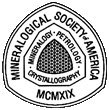 |
The Mineral Identification Key |  |
 |
The Mineral Identification Key |  |
Color is often a double-edged sword in mineral identification: There are many minerals which have distinctive colors; but there are also many which come in a variety of hues. And the same color can be seen in several different species. So one needs to use color as a criteria with care. That "malachite-green" mineral may not be malachite… That brass-yellow metallic mineral may not be pyrite… It is always a good idea to try and get a powdered streak from any colored mineral and compare it with descriptions of the streaks for the likely suspects you have in mind. It is also always wise to consider the habit of the mineral in conjunction with the color. A green prismatic crystal with a hexagonal cross-section is more likely to be elbaite than malachite. A brassy wedge-shaped crystal is more likely to be chalcopyrite than pyrite.
Color, in general, should never be taken as diagnostic by itself. While it may be for certain species, more likely than not it isn’t. Else the job of mineral identification would be made easy.
Play of Color can be more helpful than the color itself. Characteristics such as opalescence, iridescence, chatoyancy and asterism are peculiar to a limited number of species, or varieties of species.
Opalescence, as the word suggests, refers to an opal-like play of light, reflections off the mineral producing flashes of color that may appear somewhat like a patch-work of different "grains" of color that aren’t really there: Move the sample minutely and the color disappears from that spot. It is sort of like taking a pearly luster to the nth degree.
Iridescence Iridescence is the production of a rainbow of colors caused by interference of light in thin films of different refractive indices and varying thickness (the oil sheen on water is an example of this). Minerals with metallic luster, such as bornite and chalcopyrite are good examples of minerals which exhibit iridescence. A couple of cases where it does not involve metallic minerals are the way fracture surfaces in quartz may show it, and the way some fluorite crystals may exhibit it on the surfaces of their faces. Another exception is the type of iridescence known as labradoresence or schiller, found in labradorite and a very few other minerals.
Chatoyancy is the play of light off closely packed parallel fibers or parallel inclusions in cavities. The light reflects along lines – which may be straight or curved – giving the mineral a somewhat silky appearance. This characteristic is seen in such minerals as "satin spar" gypsum, "tiger’s eye" (fibrous crocidolite replaced by quartz), and chrysoberyl.
Asterism is a type of chatoyancy in which the fibers or inclusions reflecting the light are arranged in a pattern radiating outwards from a point producing a star-like pattern. This is most often seen in rubies and sapphires, and sometimes in phlogopite mica that has rutile inclusions.
Luminescence is the emission of light by a mineral other than the reflected light of the sun or a lamp – the mineral "glows" due to some other reason. The usual reason is reaction to ultraviolet light, though X-rays and electrons may produce it as well. The types of luminescence seen in minerals are fluorescence and phosphorescence – two closely related phenomena. Fluorescence results from electrons orbiting the mineral’s atoms being excited by ultraviolet light; the electrons "absorb" the energy and jump to higher orbits, then fall back to their original orbits – giving off light in the visible spectrum as they do. Phosphorescence is basically the same thing, but continues for a time after the source of excitation is removed, giving off energy as visible light more slowly. The fact is that most fluorescent minerals exhibit phosphorescence to some extent, though it usually can only be seen under careful lab conditions. Only a very few minerals phosphoresce well enough to see in a simple darkened room, and the phenomenon is usually rather short lived.
Fluorescence is a useful field identification tool for collectors who have UV lights (and a thick blanket when in the field) Many localities have at least a couple of fluorescent minerals, and some – like Franklin/Ogdensburg, New Jersey, USA – have a wealth of them. Where they are present, the UV light can be put to use in identifying them. Some animals such as scorpions also will fluoresce so be careful when picking up a fluorescent object in the field.
[ Table of Contents ] [ Introduction ] [ Identification Kit ] [ Mineral Properties ] [ Environments & Associations ] [ In Conclusion ] [ The Mineral ID Key ]